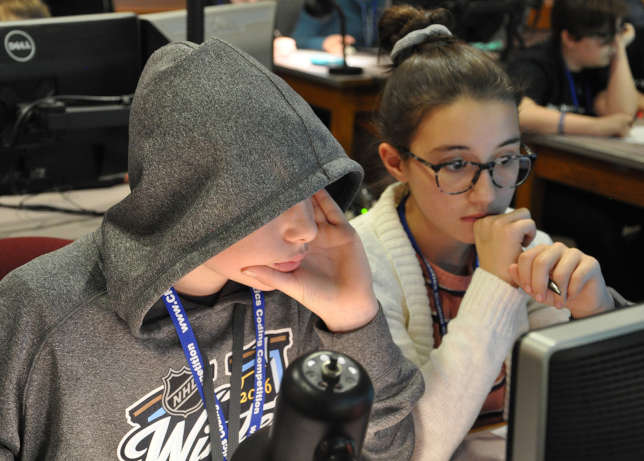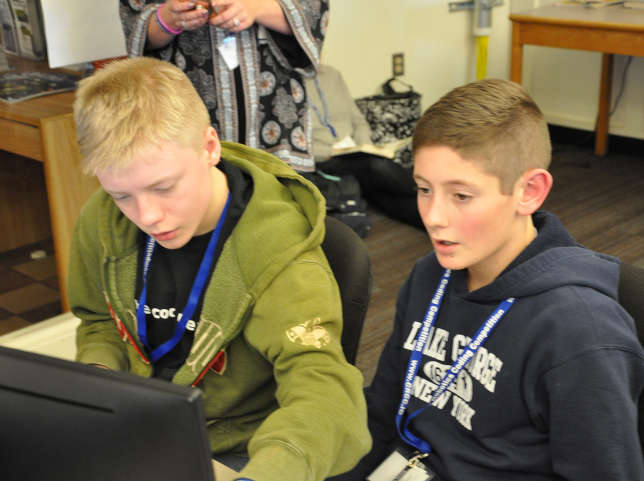Inside the Cyber Robotics Coding Competition
Coding competitions drive critical thinking and help students develop workforce skills. Here’s a look inside the recent state finals for the New Hampshire Cyber Robotics Coding Competition, held at the University of New Hampshire campus in Durham.

As
the timer on the big screen at the front of the room counted down
from 10 seconds, the students yelled in unison: “Seven. Six. Five…”
The moment the display read “00:00,” they dove into their first
coding challenge of the day.
Huddled
around computer monitors in teams of two, the students were tasked
with navigating a virtual robot through a series of exercises,
collecting objects (and points) along the way.
Working
together, they had to steer the robot toward a target, dragging and
dropping blocks of code into place on the side of the screen to
program the bot’s movements.
The
room buzzed with energy as the students got to work. Although only
one student controlled the keyboard at a time, both teammates were
engaged in solving the challenge at hand as they deliberated the
steps they would have to take.
“Let’s
test 45 degrees.”
“No,
turn it 60 degrees—then go backwards.”
The
students were competing in the finals of the 2018 New Hampshire Cyber
Robotics Coding Competition, held Dec. 15 at the University of New
Hampshire campus in Durham.
Forty-four
teams of middle and high school students from 22 schools around the
state (and one from Massachusetts) qualified for the state finals
after eight weeks of competition.
The
event was organized by the ISCEF Foundation in collaboration with New
Hampshire-based company Intelitek, whose online CoderZ
platform gives students an accessible way to learn coding skills.
CoderZ
features 3D simulations of robots operating within virtually
constructed environments. Students write code to control the bots as
they aim to solve various problems.
A
simulator feature allows students to test the code they’ve written
to see if it works as intended. If they fail, they can go back and
adjust their code as needed, working back and forth between their
code and the simulator until they accomplish the task.
The
day began in jam-packed Cole Hall with competition master Trevor Pope
addressing participants. “You’ve all come a long way since boot
camp began Oct. 15,” said Pope, who is the customer success manager
for CoderZ.
After
Pope described how the three-part finals competition would work, the
44 teams set up in computer labs around campus, with their
teacher-advisors looking on. While the two-person teams were
encouraged to work together, they were not allowed to use cell phones
or external notes.
Phase
1: The First 15 Challenges
In
phase 1,
students were given 60 minutes to complete up to 15 challenges of
varying complexity. The harder the challenge, the more points it was
worth.
The
challenges were set on a virtual farm. The first challenge, worth 100
points, was to move the robot in an arc to hit a target in the middle
of a wide-open field. But the challenges got progressively harder
from there.
A
200-point challenge required students to navigate the robot out of a
space enclosed by a fence. A 250-point challenge required them to
time the robot’s movements just right so that it would pass through
gates that moved back and forth.

At
the end of phase 1,
a team from Monadnock Regional High School was in the lead, with
1,348 points. The top middle school team was from St. Thomas Aquinas
School. Only three teams had completed as many as ten of the 15
challenges — and no team had completed more than that.
“This
is so much fun!” said one student as the competitors took their
first break.
“My
brain hurts,” said another.
The
Cyber Robotics Coding Competition began last year in New Hampshire,
with 2,600 students taking part across the state. This year, it has
grown to encompass 37,000 students in 26 states — and another
30,000 students in Vietnam.
In
New Hampshire’s second year of competing, more than 4,200 students
from 61 schools completed nearly 30,000 missions in the weeks leading
up to the finals. At least a third of those competitors were girls.
The
Curveball
Phase
2
of the competition threw a curveball at students. Instead of running
the simulator as often as they wanted to check their work, students
were limited to just five attempts per mission.
Making
the task even more daunting was the multi-step nature of the
missions. In the first one, students had to steer the robot around a
fenced-in paddock in a series of precise movements, traveling in each
compass direction and then returning to the center of the paddock in
sequence.
Having
a limited number of tries with the simulator proved challenging. “I
hope it works,” said one girl after she and her partner had
arranged multiple lines of code. She clicked on the simulator button,
and the robot began its trek — but then quickly stopped after
bumping into the fence.
A
second try five minutes later also came up short.
Fifteen
minutes into the 20-minute time limit, the leaderboard at the front
of the room refreshed — and the team from Monadnock High had become
the first to complete the mission.
“Three
more minutes,” a teacher said from the back of the room. “Make
sure you get some points,” another advised.
With
less than a minute left, a cry of “YES!” rang out as another team
completed the task. But the leaderboard remained unchanged.
As
time expired, and the students filed into the hallway for another
10-minute break, one student stopped to chat with his teacher.
“There
was just this one point where it got off a little bit,” he said.
“I
like that you’re still smiling,” she replied.

Investing
in STEM
Frank
Edelblut, New Hampshire’s education commissioner, said the Cyber
Robotics Coding Competition “dovetails nicely” with the state’s
investment in science, technology, engineering, art, and math
education.
“It’s
exciting to see kids so engaged in learning skills that are going to
be important for their future,” he said. “They’re learning, but
they’re having fun at the same time.”
In
New Hampshire alone, Edelblut said, there is an abundance of
computer-related workforce opportunities for graduates.
“If
students are interested in coding as a career, this experience is
going to be really helpful for them,” he said. “But even if they
decide not to pursue coding vocationally, the computational thinking
that students master when they learn coding helps them in math and in
other domains as well.”
“Aside
from STEAM-related concepts, participants in the coding challenge are
learning how to solve problems collaboratively”, Edelblut said.
“This is another key workforce skill that employers in any field
desire.”
“Students
love the friendly competition as well,” he added. “Ultimately,
wouldn’t it be great if students were competing in real time with
their peers around the world? My vision for this is that we could
have a 24-hour synchronous coding competition with students from all
over the globe.”
Ultimate
Challenge
In
the competition’s final phase, dubbed the Ultimate Challenge,
students had to navigate the robot around a vast space with objects
scattered throughout. Hitting green blocks added points to their
score, while hitting red obstacles subtracted points.
In
this open-ended mission, students could plot any course they wanted.
Their goal: to collect as many points as they could in the 40 minutes
allotted.
While
some teams spent time calculating an efficient route that would allow
them to amass the most points, others just leapt in and started
moving the robot around.
Two
minutes into the mission, the leaderboard began to change. A team
from Litchfield Middle School vaulted into third place.
With
30 minutes remaining, the leaderboard was turned off to build-up the
suspense.
Getting
Kids into Coding
Shannon
McCracken-Barber, a STEAM educator at Farmington High School, brought
two teams to this year’s finals.
“It
can be very difficult to get kids into coding,” she said. “In
their minds, they think it’s only for the students who are good at
math.”
The
CoderZ platform serves as a nice introduction to the subject, she
observed: “It’s fun to use, and students can get through the
missions without being frustrated. And the visuals help quite a bit.
It’s engaging visually and attainable without being kid-ish. Yet,
some of the challenges are quite tricky.”
As
students are completing the missions, “a lot of higher-order
thinking is going on,” she noted. And despite what students think,
coding isn’t just for the best and brightest.
“You
never know who’s going to be good at coding,” she said. “A lot
of kids shine who maybe don’t excel in other classes.”
There
Are No Losers
After lunch
in the UNH dining hall, the students convened in the
Paul Creative Arts Center’s Johnson Theatre for the awards
ceremony.
“We
put you under a lot of stress with a lot of hard challenges to solve,
and you all did a tremendous job,” Pope said.
North
Hampton Academy was recognized for having the highest percentage of
its student population take part in the eight-week competition: 95
percent of the school’s students in grades five through eight
competed.
With
55 girls competing, Litchfield Middle School received the Grace
Hopper Diversity Award for highest female participation. The award
was named for the Navy admiral who helped invent the COBOL computer
programming language.
The
bronze medal went to a team from Elm Street Middle School, with 1,658
points in the finals competition. Silver went to the team from
Litchfield Middle School, with 1,728 points.
The
middle school champion was the team from St. Thomas Aquinas School in
Derry, with 1,848 points. The high school champion was the Monadnock
team, with 1,983 points.
While
these particular teams were honored during the awards ceremony, there
were no losers.
“It
was very challenging, but I had fun,” said Farmington High School
junior Conner Beaton, one of McCracken-Barber’s students. “I
could see myself doing this in the future.”
About the Author
Dennis Pierce is a freelance writer with 17 years of experience covering education and technology. He can be reached at [email protected].